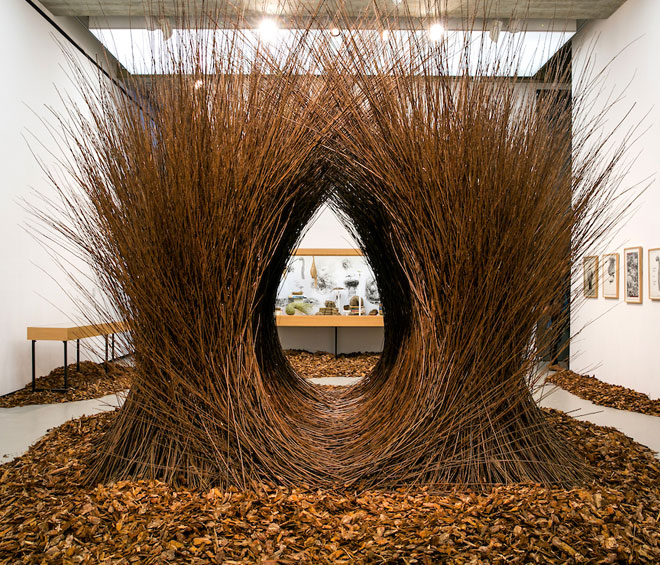
by EMILY SPICER
Andy Holden (b1982) knows a thing or two about birds. His father, Peter Holden, is an ornithologist who began working for the Royal Society for the Protection of Birds in the 1960s. Holden senior was responsible for the charity’s youth drive and went on to co-present Bird in the Nest, a BBC1 series that aired in the 90s. The artist has learned a lot from his father, but their interests in the natural world follow different lines of enquiry. “Sometimes I think I just want to marvel at the bowerbird,” he says of a species known for adorning twig structures with colourful finds in the hope of attracting a mate, “and then my dad offers lots of explanations for it and it makes it more complicated.” But Holden makes room for both narratives in his current exhibition, Natural Selection, at the Towner Gallery in Eastbourne, and father and son discuss birds’ nests together in a video piece split between three screens, which is cosily reminiscent of 80s educational programmes.
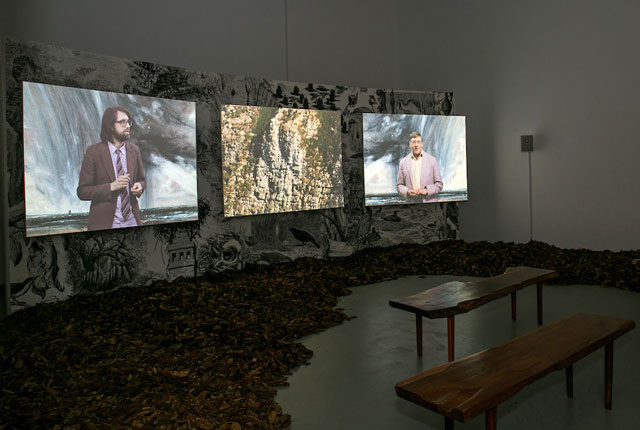
Andy Holden and Peter Holden. Natural Selection. Installation view, Towner Gallery, 2018. Photograph: Pete Jones.
The end of the video introduces the bowerbird, and in the central room of the exhibition, Holden has built a large version of the structure that gives the bird its name. “That object is quite magical when you scale it up,” he tells me, “it has a kind of pagan, iconic feel.” The last two rooms are reserved for human follies. A video about the history of egg collecting discusses, with the help of an animated crow voiced by Holden, the complex social and psychological motivations behind hoarding nature’s most iconic symbols of perfection.
Holden is adept at posing profound, often existential questions in relatable terms through an extraordinary range of media. Past projects have seen him explore the laws of motion in cartoons, tour his grandmother’s collection of china cats as part of a comedy routine, re-enact a childhood manifesto with actors, and construct an enormous sculpture from wool, based on a small rock he picked up in Giza when he was a child. This incredible diversity of approach helps to make Holden one of the most engaging artists of his generation.
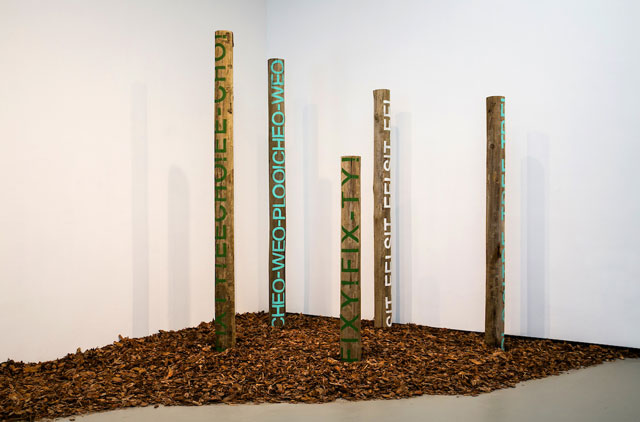
Andy Holden and Peter Holden. Natural Selection. Installation view, Towner Gallery, 2018. Photograph: Pete Jones.
Emily Spicer: This exhibition explores collecting and the connection between nature and art, but it also explores the relationship between you and your father.
Andy Holden: It’s not always the first thing that comes across, but it’s generally the second. Or, if you don’t feel that, then it probably got lost in the labyrinth of bird facts. I don’t think the show would be very interesting if it didn’t have that second, gentle metaphor underneath. It’s like all my work, in that it is explicitly about my father and me, but only as a way of talking about something more abstract – what is innate to you, and what is learned; how much of that is genetics and how much of that is socially arrived at.
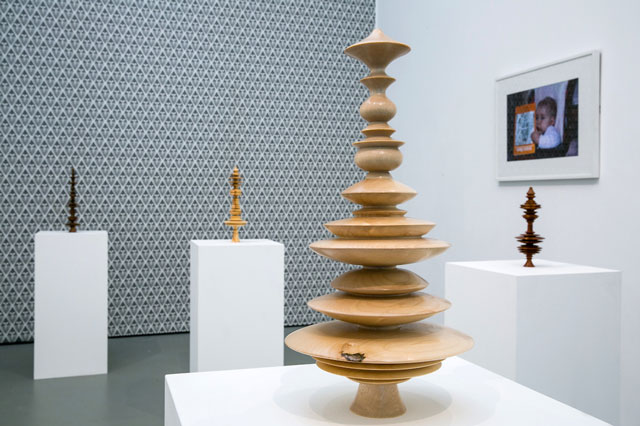
Andy Holden and Peter Holden. Natural Selection. Installation view, Towner Gallery, 2018. Photograph: Pete Jones.
ES: The first film of the exhibition looks at creative solutions to nesting, which seems like the perfect ground for exploring inherited behaviours v individual innovations.
AH: There is a lucky doubling because the metaphor of ornithology was a really good way of exploring that. Particularly when you’re interacting with material. If [a bird] is using moss and lichen to make a nest – how much of that is because it is all it can do and how much is down to what it is innately predisposed to do? How much of it is because it has observed its parents and how much is free will? So, that is certainly one of the main themes that sits underneath the show.
ES: What about your relationship with birds? Is that something you have learned from your father?
AH: People feel that my understanding of birds is maybe more innate, or natural, but actually it isn’t. Particularly considering my dad was in charge of getting children interested in birds. It’s not that it had the opposite effect, it’s just that it didn’t have the desired effect. I couldn’t fake it and it was kind of disappointing for him. He would lead trips with other kids, and they would clearly be interested and I would just drag myself along. Quite soon, I found my own shape to things, which was making artworks or music in the studio.
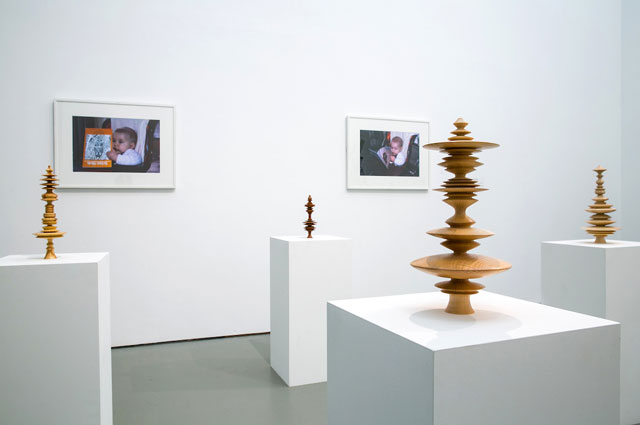
Andy Holden and Peter Holden. Natural Selection. Installation view, Towner Gallery, 2018. Photograph: Pete Jones.
ES: When did your interest in birds develop?
AH: I came back to birds in my late 20s when I was living at home again. I was thinking about what I could make at the time and I got interested in birds’ nests as a material construct, as little sculptural objects. So, it’s only in the past five years that I have found that I really needed to immerse myself in nature writing. A lot of that was to be able to make the work, but also it was about finding a language to talk to [my father] through, because you have to learn, when you live with your parents again as an adult, that you need to get to know them as an adult. If it’s going to work, you can’t just replicate the parent-child model. And to do that, as to get on with anyone, you have to engage with the things they’re interested in and, it turns out, those weren’t so different from the things I’m interested in.
ES: References to your childhood are common in your work. Return of the Pyramid Piece involved returning a piece of rock that you took from a pyramid at Giza as a child. Is your work an expression of nostalgia? Is there something you are trying to regain, or perhaps something you are trying to re-examine?
AH: Re-examine is a word I often use, because what I do is take something from the past to try to make sense of the present. So much of the way you process the present is rooted in very particular experiences of the past. The pyramid piece is essentially going back to return the piece of rock in order to undo the past. It had been a moment of learning about ethics and experiencing a kind of guilt around how to be in the world; what you can and can’t take.
I am a nostalgic person, but I think [my work] is more about how much our culture is pervaded by nostalgia. Anything around Brexit, or anything around contemporary politics at the moment is completely rooted in a dialogue with an imaginary past. So, for me, it was an examination of that, a way to reperform it, to allow it to be re-examined and made visible.
ES: What about the rock you took from the pyramid. You went to great lengths to put it back in the right place. Did you find the right spot or did you just guess?
AH: I thought I could picture where it was. It was kind of a false memory, I think, because, when I got there, that angle didn’t really seem to exist, so it became about what looked right. A lot of my work is a fidelity to what feels right more than an objective truth.
ES: You painstakingly recreated this rock on a monumental scale using a huge amount of wool. Was the project a kind of penance? Were you trying to assuage the guilt or was it purely an exploration of the memory?
AH: The guilt of taking it was real, but the idea of it being penance makes it sound a lot more Christian than it was intended to be. It was more about whether you can go back and undo something. Also, it was ridiculous. It was an overblown gesture for something so trivial.
ES: I want to ask about the bowerbird, which is famous for collecting and arranging found objects in order to attract a mate. Your video suggests that these birds have aesthetic sensibilities. Are we anthropomorphising nature, or are these birds really the artists of the natural world?
AH: It’s very easy to reduce [the bird’s actions] down to an argument of sexual selection. You can always make a biological argument, but it feels kind of dumb not to think that there is more going on, to try to put it all down to sex. But these evolutionary arguments don’t stop the sense of wonder. The two things aren’t mutually exclusive; you can have both. You can still marvel at something and also try to understand it and I think that’s what the show keeps trying to do. I think it’s interesting. We do it with art a lot. We look at work and think that’s marvellous! And then we want to know what the artist’s intentions were and we want to know what the zeitgeist was at the time or what the politics were, to help us understand the gesture, and it doesn’t make the artwork less interesting. The show is playing with the same dichotomy. Lots of my work does that, I think.
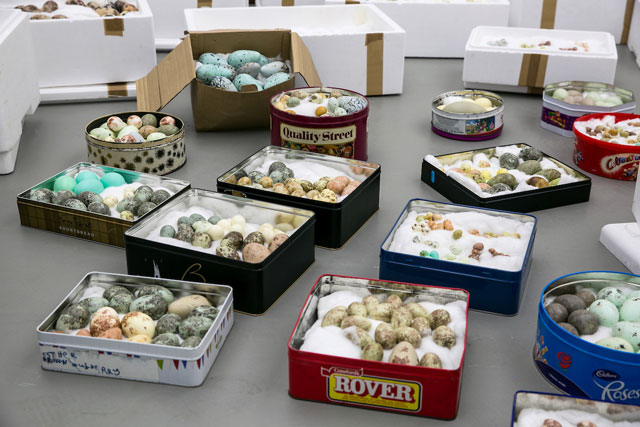
Andy Holden and Peter Holden. Natural Selection. Installation view, Towner Gallery, 2018. Photograph: Pete Jones.
ES: You explore egg collecting in the latter part of this exhibition. What gratification do you think people get from such a divisive activity?
AH: You know what, after all the research, I still don’t know. The film positions it socially. Great aristocratic collectors went out and collected, they created beautiful museums and made these available to the public. Collecting was encouraged; we socially generated it. There was a sense that it was a model to understanding the world, to collect eggs to look at them in isolation was kind of a trope of early modernism – you take something out of context.
The film is a little ethically complicated because it does show at times that it wasn’t just destructive. Some people, of course, channel it towards a destructive urge and the egg is the perfect symbol of the beautiful thing. It’s really collecting with the temperature turned right up, because it’s so different from trains or matchboxes. All the things that are inherently perverse about collecting are made 10 times more visible in egg collecting. It’s about wanting something perfect and creating a world around yourself and about controlling the world – all of these pathological things.
ES: Artists tend also to be collectors. Do you identify with an impulse to collect?
AH: I think if I wasn’t a maker of things, I’d be a collector of things. I’ve probably become less of a collector because I’m quite a prolific maker. I’ve got a 2,000 sq ft [186 sq metre] warehouse at work and I don’t sell that much, so I just keep the things I make. But it’s still about gathering things around you or making sense of the world. I just do it through transforming things. But a lot of my work deals with the collecting impulse. It is about collecting imagery, or archiving a certain something and putting that together. And examining someone else’s collection is a good way of working something out about the world.
ES: You have said that, as a child visiting Egypt, you took a small rock from a pyramid because you wanted to take home something authentic, not just a souvenir from a shop. It seems to me that the search for something authentic, something imbued with history and meaning beyond the physical object itself, is what separates us from the bowerbird, for example. They don’t care whether the shiny object they’re adding to their arrangement is a vintage Coca-Cola bottle cap. So if we talk about art in the context of the natural world, it seems to me that sentimentality is the thing that separates us from the animal kingdom.
AH: I think that’s a brilliant point. I can think of something to counter it, but I think that’s really true. I think it’s really brilliant, the idea that there is no sentimentality in nature. But there is this thing with octopuses. When they’re caught in traps on the bottom of the sea, they often pick up a rock and bring it up with them. It’s a rock they’re fond of; it’s a way of not letting go. They hold it like a child’s toy or the way you hold something in a moment of desperation. There’s something noble about it, too. I always think about these octopus rocks. There’s so much about animal interactions that we don’t know and the bowerbird is just a visible iteration.
I did a talk in Los Angeles a few years ago and it really haunted me. Someone who was so sharp asked me: “Isn’t all your work just some desperate attempt to find some kind of significance?” I was like, oh shit! Is that it? Is it just some desperate attempt to find meaning in animal objects? I remember thinking it was positioned as a massive insult, but when I got home I thought, maybe that’s OK. Maybe that’s what [my work] is. I think that’s what I thought art was supposed to be. I just want to understand what’s going on with our relationship with objects in the world.
• Andy Holden & Peter Holden: Natural Selection is at Towner Gallery, Eastbourne until 20 May 2018.